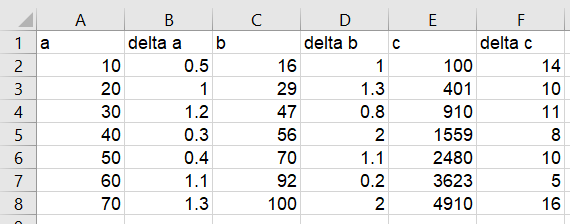Writing Data Files¶
Data File Formats¶
Eddington excepts data files in 3 formats: CSV, Excel, and Json. In this tutorial we will walk through the syntax of each format.
CSV File¶
CSV data files should have a headers row followed by records rows, each column represent a specific value of the record. For example:
a,delta a,b,delta b,c,delta c
10,0.5,16,1,100,14
20,1,29,1.3,401,10
30,1.2,47,0.8,910,11
40,0.3,56,2,1559,8
50,0.4,70,1.1,2480,10
60,1.1,92,0.2,3623,5
70,1.3,100,2,4910,16
Json File¶
As for Json files, it should be written as a dictionary, with each header as the key mapped to it’s values. For example:
{
"a": [10, 20, 30, 40, 50, 60, 70],
"delta_a": [0.5, 1.0, 1.2, 0.3, 0.4, 1.1, 1.3],
"b": [16.0, 29.0, 47.0, 56.0, 70.0, 92.0, 100.0],
"delta_b": [1.0, 1.3, 0.8, 2.0, 1.1, 0.2, 2.0],
"c": [100.0, 401.0, 910.0, 1559.0, 2480.0, 3623.0, 4910.0],
"delta_d": [14.0, 10.0, 11.0, 8.0, 10.0, 5.0, 16.0]
}
Warning
The order of each values list should be the orders of the records. Mismatching the order may cause fitting errors.
Specify The Data Columns¶
Whatever the data file format you choose, you should specify the columns to be used for the fitting. By default the first 4 columns are used as the x, x error, y and y error in that order. That means that in our example “a” will be taken as x, “delta_a” will be taken as the x error, “b” will be taken as y and “delta_b” will be taken as the y error.
Common Errors¶
If you encounter a loading error while trying to load a data file, it may be caused by one of the following problems:
- One or more of your records has non-float value or it is blank.
- In Excel files, you may have added an additional cell outside of the records table.
- In Excel and CSV files, you might have missed adding a headers row
- In Json, one or more of your columns has different length than the others (which means a record is missing a value).
